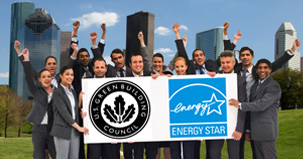- Home
- Smart Data
Smart Data
Actionable intelligence on energy and water use:
- Helps users identify inefficencies, and waste
- Provides real-time feedback on conservation
Right data for the right audience:
- Facility managers identify when and where energy is wasted
- CFO's can track and verify financial savings from initiatives
- Company knows its carbon and water footprint
Related Products
 Information any time, anywhere
Information any time, anywhere - Smart User
Smart User
Smart users leverage real-time data and reduce energy and water use by:
- Continuously identifying opportunities
- Acting on opportunities
- Tracking and verifying savings
- Sustaining savings
Related Products
 Monitor, Manage, Maintain
Monitor, Manage, Maintain - Smart Community
Smart Community
A smart community is one where all stakeholders are engaged in energy and water conservation. A smart community can be achieved by:
- Showing people precisely how much they are using
- Providing real-time feedback on conservation actions
- Effectively communicating efficiency results
Related Products
 Communicate and Conserve
Communicate and Conserve - Smart Grid
Smart Grid
Smart grid, as we define it, is a "green grid", with efficient resource use and the key to a low-carbon future. We help our customers prepare for the smart grid by:
- Engaging users with smart data
- Enabling smart users to increase resource efficiency
- Educating & empowering smart communities
Related Products
 Smart grid and a smarter future
Smart grid and a smarter future - Smart Buildings
Smart Buildings
Smart buildings maximize resource (energy, water, capital) efficiency. These buildings are optimized using energy and water management process with high data visibility which lead to reduced energy and water spending.
- Higher operating income and higher asset values for owners
- Increased productivity for occupants
- Lower carbon footprint for the community
 Resource efficient buildings
Resource efficient buildings
Recent Posts
Does Sustainability Impact Brand Value? You Better Believe It!
Honda’s brand value increased 28 percent and GE’s 17 percent because of their initiatives in sustainability. Honda was ahead of the rest of the global auto industry in fuel-efficiency. GE created the Ecoimagination division which has been the corporation’s green driver. No surprise other major brand names, ranging from Procter & Gamble to Wal-Mart, also have made sustainability a priority.
“Sustainability” can be defined in many ways. The most comprehensive and useful comes from the Dow Jones Sustainability Indexes. There, it’s defined as “a business approach that creates long-term shareholder value by embracing opportunities and managing risks from economic, environmental and social developments.
”Bingo! That’s right on the money. Shareholder value is now determined directly and indirectly by the value of the brands. Interbrand and JP Morgan conducted a study which found that, on average, brands constitute more than a third of shareholder value.
Sustainability has become a key aspect of the brand because investors, global and national government regulators, environmental activists, and consumers recognize that it covers a lot. That “a lot” includes office operations, production ranging from raw materials to packaging, supply chain management, marketing, and distribution.
And, those translate into, first and foremost, the cost of doing business.
A survey by McKinsey Global this year found “this concern for costs replaces reputation as the most frequently chosen reason” for making sustainability a core value. The most obvious example is that energy-efficient processes and distribution significantly reduce expense. With a global downturn, expense is a matter of survival.
However, in this era when organizations “live in glass houses,” reputation is more and more important. No entity, including government and nonprofits, can risk being careless about impacts to planet earth. Take the controversy over the 18 billion disposable diapers used annually just in the United States. According to the Sustainability Institute, those wind up as 82,000 tons of plastic in landfills. Diverse forces, from Mommy Bloggers to actual diaper manufacturers, are searching for solutions.
No surprise then, even luxury brands have responded to enhancing sustainability. They have done it in what differentiates them in the marketplace: packaging. That aspect of their marketing is the most polluting. In upscale cosmetics, both Estee Lauder and L’Oreal have addressed this. Paperboard, which is the best bet for green, is being more widely adopted in the luxury sector.
So, how is brand value calculated? At one time, branding was treated even by the bean-counters in major corporations as an intangible whose worth couldn’t be pinned down for the balance sheet. In the late 1980s, that began changing. Interbrand explains that financial value can be determined in a variety of ways. One method is to apply all the following five steps:
- Market segmentation
- Financial analysis
- Demand analysis
- Competitive benchmarking
- Brand value calculation.
Here you can read the details of how this exercise is performed.With the growth of “personal branding” or the recommendation that individuals set themselves apart from others in professional life, sustainability will also be expected in how people work and live. It could come to be that a 90-imnute commute one-way by car with a sole driver will be perceived as unacceptable. The McMansion for the empty-nest couple will be, too.
Perhaps the best thing individuals and companies can do is mind their own business – literally. By monitoring energy usage and measuring individual commitment to sustainability, there is an increased chance that it will all add up to a meaningful end. Quite frankly, how could it not?
Sustainability will continue to reshape how business, nonprofits, government, and even individuals conduct themselves. Those not willing or able to keep reducing their negative impacts on planet earth will be labeled the “bad guys” – and treated as such.



